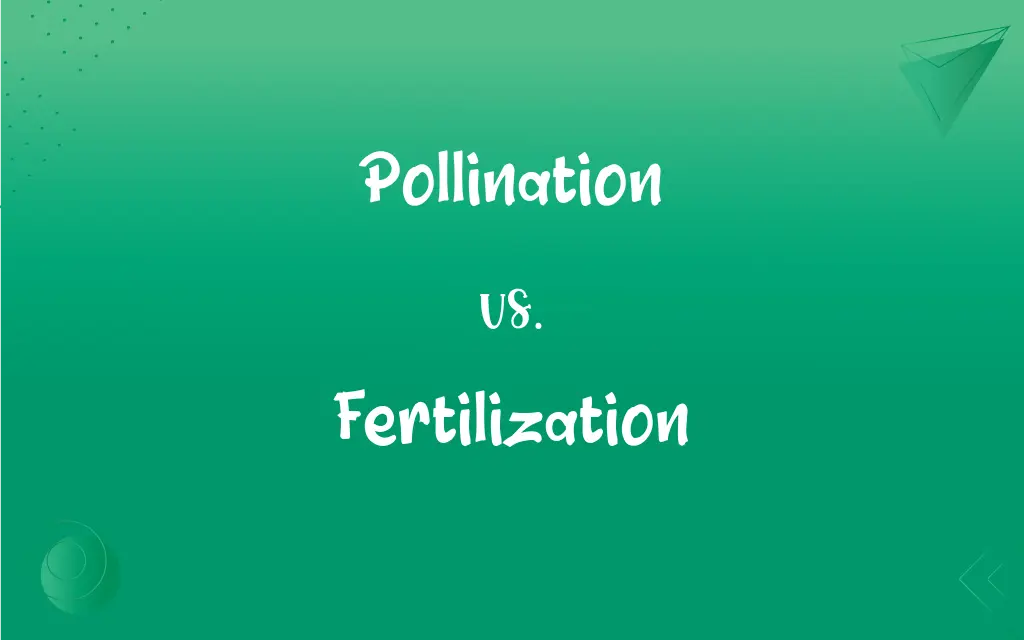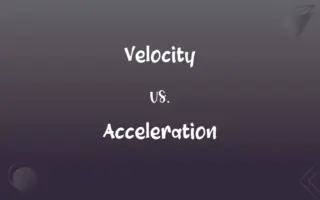Pollination vs. Fertilization: What's the Difference?
Edited by Janet White || By Harlon Moss || Updated on October 19, 2023
Pollination is the transfer of pollen from anther to stigma, while fertilization is the fusion of male and female gametes to form a zygote.

Key Differences
Pollination refers to the process where pollen grains are transferred from the male part (anther) of a flower to the female part (stigma) of either the same flower or a different one. On the other hand, fertilization is the event following pollination where the male gamete within the pollen grain combines with the female gamete, resulting in the formation of a seed.
The primary goal of pollination is to ensure that pollen reaches the stigma. This can happen through various agents like wind, water, insects, or animals. Fertilization, in contrast, is solely about the merging of genetic material to produce offspring, ensuring genetic variation in the next generation.
While pollination can be of two types – self-pollination (within the same flower) and cross-pollination (between two flowers), fertilization is universally about the fusion of gametes, irrespective of whether the pollen came from the same flower or a different one.
Pollination is an external process visible to the naked eye, characterized by the movement of pollen. Fertilization, however, is an internal cellular process, typically happening within the ovule of the flower, invisible without microscopic observation.
It's essential to understand that pollination doesn't guarantee fertilization. While pollination sets the stage for the potential fusion of gametes, various factors, including compatibility and environmental conditions, influence the success of fertilization.
ADVERTISEMENT
Comparison Chart
Definition
Transfer of pollen from anther to stigma
Fusion of male and female gametes
Purpose
Ensure pollen reaches the stigma
Produce offspring through the combination of genetic material
Visibility
External and often visible
Internal and requires microscopic observation
Types
Self-pollination and cross-pollination
Universal fusion of gametes
Dependency
Can occur without fertilization
Dependent on successful pollination
ADVERTISEMENT
Pollination and Fertilization Definitions
Pollination
The initial step towards seed production in plants.
Pollination by wind is common in grasses and grains.
Fertilization
A process following pollination, culminating in seed development.
After fertilization, the flower's ovule begins transforming into a seed.
Pollination
A mechanism ensuring genetic diversity in flowering plants.
The butterfly's visit resulted in the pollination of several blossoms.
Fertilization
The fusion of male and female gametes to form a zygote.
Fertilization leads to the formation of seeds in many plants.
Pollination
The act of transferring pollen from anther to stigma.
Bees play a crucial role in the pollination of many flowering plants.
Fertilization
An internal cellular event leading to offspring production.
In humans, fertilization typically occurs within the fallopian tubes.
Pollination
A necessary process for reproduction in flowering plants.
Without pollination, many plants wouldn't be able to produce seeds.
Fertilization
The combination of two distinct sets of genetic data.
Fertilization ensures that offspring inherit traits from both parents.
Pollination
The interaction between flowers and pollinating agents.
Human intervention, like hand pollination, can assist plants in areas with fewer natural pollinators.
Fertilization
The union of genetic material from two parent organisms.
The miracle of life starts with the simple act of fertilization.
Pollination
To transfer pollen from an anther of an angiosperm to (a stigma, flower, or plant).
Fertilization
The act or process of initiating biological reproduction by insemination or pollination.
Pollination
To transfer pollen from a microsporangium of a gymnosperm to (an ovule, cone, or plant).
Fertilization
The union of male and female gametes to form a zygote.
Pollination
(botany) The transfer of pollen from an anther to a stigma; effected by insects, birds, bats and the wind etc.
Pollination
Transfer of pollen from the anther to the stigma of a plant
FAQs
What happens after successful fertilization in plants?
After successful fertilization, a seed is formed which can grow into a new plant.
Can pollination occur without fertilization?
Yes, pollination can occur without subsequent fertilization.
Are bees important for pollination?
Yes, bees are vital pollinators for many flowering plants.
What's the benefit of cross-pollination over self-pollination?
Cross-pollination promotes genetic diversity, while self-pollination can limit it.
Can human activities disrupt pollination?
Yes, actions like pesticide use or habitat destruction can harm pollinators.
How can farmers ensure better fertilization of crops?
Farmers can employ techniques like crop rotation, using pollinator-friendly plants, or even hand-pollination.
Where does fertilization typically occur in flowering plants?
Fertilization typically occurs within the ovule of the flower.
Can a flower be both pollinated and fertilized by itself?
Yes, this is called self-pollination and can lead to self-fertilization.
Can plants be genetically modified to enhance fertilization?
Yes, some plants are modified for improved fertilization rates or self-fertility.
How does fertilization ensure genetic variation?
Fertilization combines genes from two parents, creating varied genetic combinations.
How do insects aid in pollination?
Insects transfer pollen from one flower to another while seeking nectar.
Why is fertilization essential for sexual reproduction?
Fertilization combines genetic material from two parents, producing offspring.
What is the primary purpose of pollination?
Pollination's main purpose is to transfer pollen from the anther to the stigma.
What is a key difference between pollination and fertilization?
Pollination is about pollen transfer, while fertilization is the fusion of gametes.
Is fertilization necessary for a plant to produce fruit?
Typically, yes. Fertilization usually triggers fruit development in plants.
What are common agents of pollination?
Common agents include wind, insects, birds, and water.
What role does the wind play in pollination?
Wind can carry and deposit pollen grains from one flower to another.
What role do birds play in pollination?
Some birds, like hummingbirds, transfer pollen while feeding on flower nectar.
Are all plants pollinated the same way?
No, different plants have different pollination mechanisms and agents.
What is double fertilization?
It's a process in some plants where two male gametes fertilize two different cells, leading to seed and endosperm formation.
About Author
Written by
Harlon MossHarlon is a seasoned quality moderator and accomplished content writer for Difference Wiki. An alumnus of the prestigious University of California, he earned his degree in Computer Science. Leveraging his academic background, Harlon brings a meticulous and informed perspective to his work, ensuring content accuracy and excellence.
Edited by
Janet WhiteJanet White has been an esteemed writer and blogger for Difference Wiki. Holding a Master's degree in Science and Medical Journalism from the prestigious Boston University, she has consistently demonstrated her expertise and passion for her field. When she's not immersed in her work, Janet relishes her time exercising, delving into a good book, and cherishing moments with friends and family.































































